Pleistocene Glacial Transport of Nephrite Jade from British Columbia, Canada, to Coastal Washington State, USA
Abstract
:1. Introduction
2. Historical Importance of Glacially Transported Nephrite
3. Salish Sea “Black Jade”
3.1. Late Pleistocene Sediment Transport
3.2. Age of Glacial Transport of Nephrite
3.3. Bedrock Source of Transported Sediment
4. Analytical Methods
5. Mineralogy of the Salish Sea “Black Jade”
5.1. X-ray Diffraction
5.2. SEM/EDS
5.3. Physical Properties
6. The “Muttonfat Jade” Enigma
7. Discussion
8. Conclusions
Funding
Data Availability Statement
Acknowledgments
Conflicts of Interest
References
- Tabor, R.W. Late Mesozoic and possible early Tertiary accretion in western Washington State. Geol. Soc. Am. Bull. 1994, 106, 217–232. [Google Scholar] [CrossRef]
- Brown, E.H. Mountain Building Geology in the Pacific Northwest; Chuckanut Editions: Bellingham, WA, USA, 2017; p. 146. ISBN 1068 9780999527801. [Google Scholar]
- Ream, L.R. Nephrite Jade of Washington and Associated Gem Rocks: Their Origin, Occurrence and Identification; LR Ream Publishing: Coeur d’Alene, ID, USA, 2022; p. 120. ISBN 978-1-387-79127-9. [Google Scholar]
- Ream, L.R. Washington gem jade. Lapid. J. 1974, 28, 708–711. [Google Scholar]
- Lore of the Rings. Available online: https://en.chinaculture.org/a/202403/02/WS65e2ce27a31082fc043ba2d1_3.html (accessed on 21 August 2024).
- Semyotsov, A.A.; Dolukhanov, P.; Romanov, Y.N.; Timofeyev, V.I. Radiocarbon dates of the Institute of Archaeology III, Nephrite edges and rings. Radiocarbon 2016, 14, 336–337. [Google Scholar] [CrossRef]
- Richardson, J. A Journal of a Boat Voyage Through Rupert’s Land and the Arctic Sea in Search of the Discovery Ships under Command of Sir John Franklin; Cambridge University Press: Cambridge, UK, 1851; Volume 1, p. 312. [Google Scholar] [CrossRef]
- Dawson, G.M. Note on the occurrence of jade in British Columbia and its employment by the Natives. Can. Rec. Sci. 1887, 2, 1–15. [Google Scholar]
- Emmons, G.T. Jade in British Columbia and Alaska, and its use by the Natives. In Indian Notes and Monographs 35; Museum of the American Indian; Hodge, F.W., Ed.; Heye Foundation: New York, NY, USA, 1923; pp. 9–53. [Google Scholar]
- Morin, J. Nephrite Jade: The Preeminent Celt Stone if the Pacific Northwest, Chapter 2. In Toolstone Geography of the Pacific Northwest; Ozbun, T.L., Adams, R.L., Eds.; Archaeology Press, Simon Fraser University: Burnaby, BC, Canada, 2015; pp. 12–28. Available online: https://archpress.lib.sfu.ca/index.php/archpress/catalog/download/20/6/118-1?inline=1 (accessed on 3 May 2024).
- Morin, J. The Political Economy of Pre-Contract Trade and Exchange of Stone Celts in British Columbia: The Salish Nephrite/Jade Industry. Ph.D. Thesis, Department of Anthropology, University of British Columbia, Vancouver, BC, Canada, 2012; p. 736. [Google Scholar]
- Morin, J. The Salish nephrite/jade industry: Ground stone celt production in British Columbia, Canada. Lithic Technol. 2016, 41, 39–59. [Google Scholar] [CrossRef]
- Darwent, J. The Prehistoric Use of Nephrite on the British Columbia Plateau; Publication No. 25; Simon Fraser University Archaeology Press: Burnaby, BC, Canada, 1998; Volume 134, p. 7. [Google Scholar]
- Fraser, M. Nephrite jade, the stone of heaven. Can. Rockhound 2000, 4, 1–4. [Google Scholar]
- Makepeace, K.; Simandl, G.J. Jade (nephrite) in British Columbia, Canada. In 37th Annual Forum on Industrial Mineral Proceedings, Industrial Minerals with Emphasis on North America, Paper 2004-4-3-57; McWilliam, W.J., Robinson, N.D., Eds.; Ministry of Energy and Mines, Geological Survey Branch: Victoria, BC, Canada, 2001; pp. 287–288. [Google Scholar]
- Leaming, S. Jade in Canada; Geol. Survey Canada 78-19: Ottawa, ON, Canada, 1978; p. 59. ISBN 13 9780660100616. Available online: https://emrlibrary.gov.yk.ca/gsc/papers/78-19.pdf (accessed on 23 August 2024).
- Leaming, S. Jade Fever, Hunting the Stone of Heaven; British Columbia Arts Council, Heritage House Press: Surrey, BC, Canada, 2005; p. 208. ISBN 1-894384-85-7. Available online: www.heritagehouse.ca (accessed on 20 August 2024).
- Jutras, J.P.; Williams, C.; Williams, B.; Rossman, G.R. Nephrite jade from Washington State, USA, including a new variety showing optical phenomena. J. Gemmol. 2023, 38, 494–511. [Google Scholar] [CrossRef]
- Easterbrook, D.J. Advance and retreat of the Cordilleran ice sheets in Washington, USA. Géogr. Phys. Et Quat. 1992, 56, 51–68. [Google Scholar]
- Thorsen, R.M. Ice-sheet glaciation of the Puget lowland during the Vashon Stade (late Pleistocene). Quat. Res. 1980, 13, 303–321. [Google Scholar] [CrossRef]
- Thorsen, R.M. Glacio-isostatic response of the Puget Sound area, Washington. Geol. Soc. Amer. Bull. 1989, 101, 1163–1174. [Google Scholar] [CrossRef]
- Porter, S.C.; Swanson, T.W. Radiocarbon age restraints on rates of advance and retreat of the Puget Lobe of the Cordilleran Ice Sheet during the last glaciation. Quat. Res. 1998, 59, 205–213. [Google Scholar] [CrossRef]
- Kovanen, D.J.; Slaymaker, O. Relict shorelines and ice flow patterns of the northern Puget Lowland from lidar data and digital terrain modelling. Geogr. Ann. 2004, 86A, 385–400. [Google Scholar] [CrossRef]
- Kovanen, D.J.; Haugerud, R.A.; Easterbrook, D.J. 2020, Geomorphic Map of Western Whatcom County, Washington, Verson. 1.1, November 2021; U.S. Geological Survey Scientific Investigations Map: Denver, CO, USA, 2020; p. 42. [Google Scholar] [CrossRef]
- Clague, J.J. Late Quaternary Geology and Geochronology of British Columbia, Part 2: Geological Survey of Canada Paper 80–35; Energy, Mines & Resources Canada: Ottawa, ON, Canada, 1981; Volume 1, p. 41. [Google Scholar]
- Easterbrook, D.J. Pleistocene stratigraphy of Island County, State of Washington. In Water Supply Bulletin 25; Department. of Water Resources: Olympia, WA, USA, 1968; pp. 1–34. [Google Scholar]
- Dethier, D.P.; Dragovich, J.D.; Sarna-Wojcicki, A.M.; Fleck, R.J. Pumice in the interglacial Whidbey Formation at Blowers Bluff, central Whidbey Island, WA, USA. Quat. Int. 2008, 178, 229–237. [Google Scholar] [CrossRef]
- Actinolite. Available online: https://www.mindat.org/min-18.html (accessed on 20 August 2024).
- Bradt, R.C.; Newnham, R.E.; Biggers, V.V. The toughness of jade. Am. Mineral. 1973, 58, 727–732. [Google Scholar]
- Fetherston, J.M.; Stocklmayer, S.M.; Stockelmayer, V.C. Gemstones of Western Australia. In Mineral Resources Bulletin 25, 2nd ed.; Geological Survey of Western Australia: Perth, Australia, 2017; pp. 274–276. [Google Scholar]
- Monger, J.H.W. Geology of the Hope and Ashcroft Map Areas, British Columbia Maps 41-1989 and 42-1989; Geological Survey of Canada: Victoria, BC, Canada, 1989. [Google Scholar]
- Monger, J.H.W.; Brown, E.H. Tectonic evolution of the southern Coast-Cascade Orogen, northwestern Washington and southwestern British Columbia. In The Geology of Washington and Beyond; Cheney, E., Ed.; Washington Division of Geology and Earth Resources: Olympia, WA, USA, 2016; pp. 101–130. [Google Scholar]

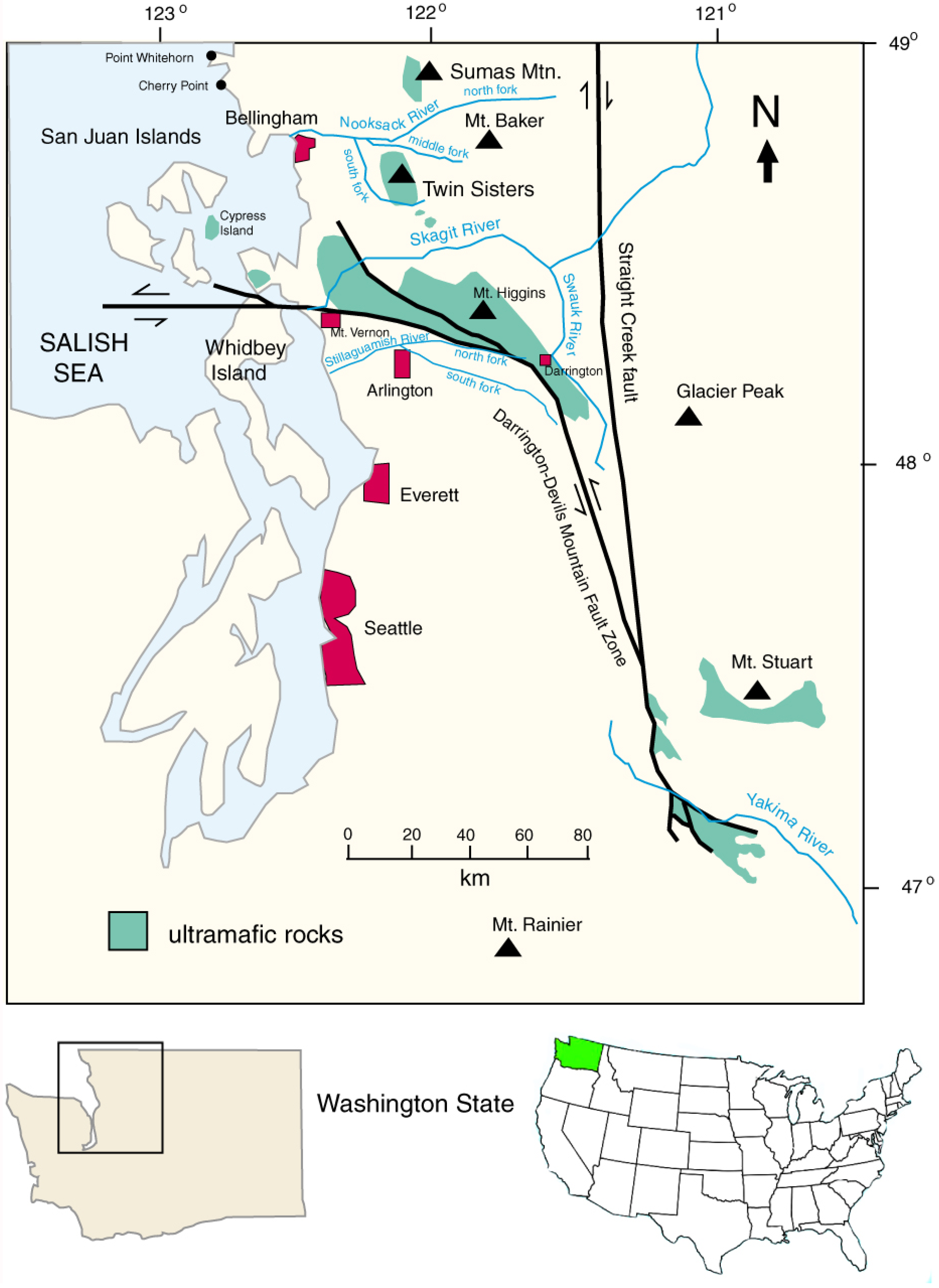
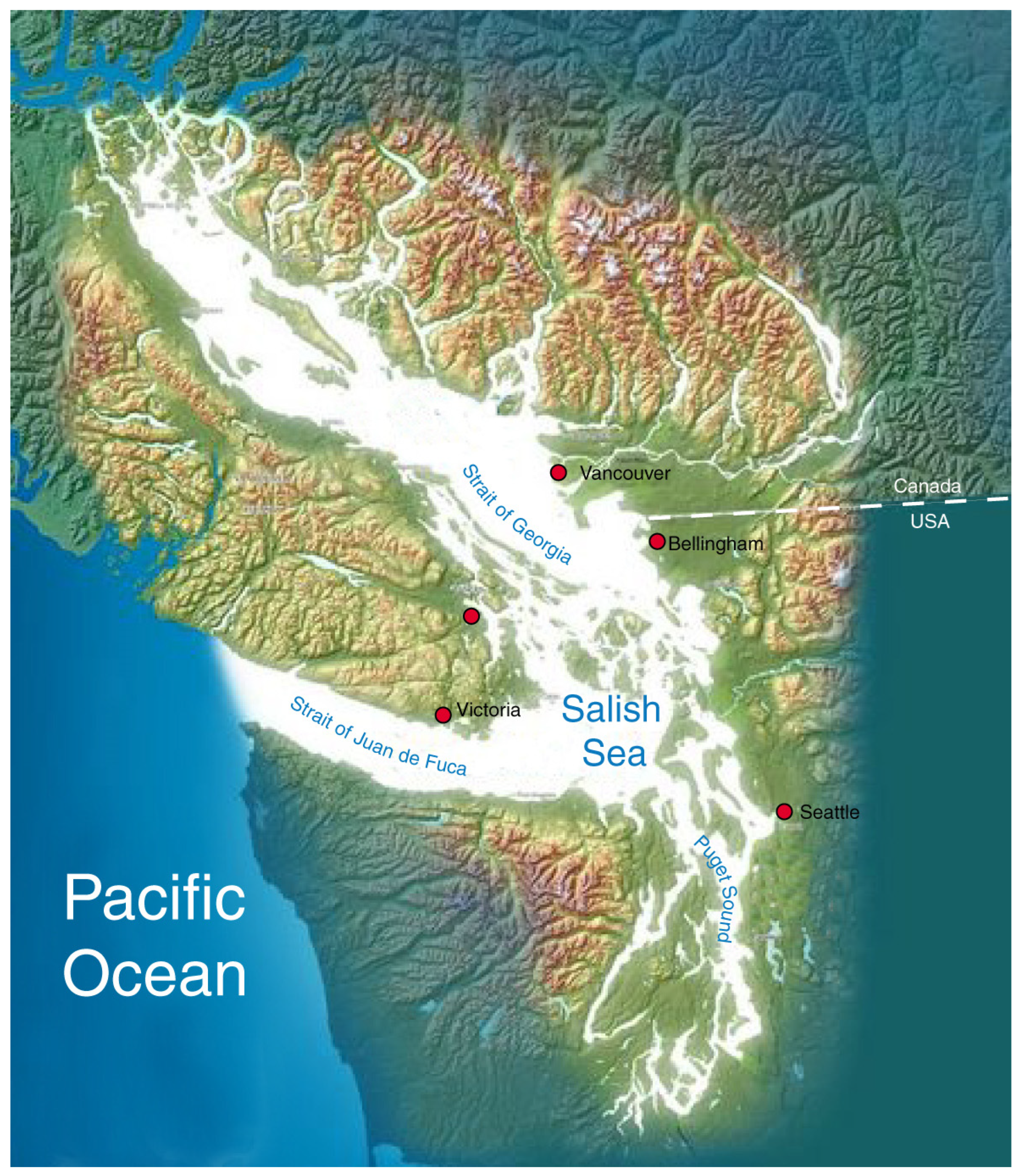
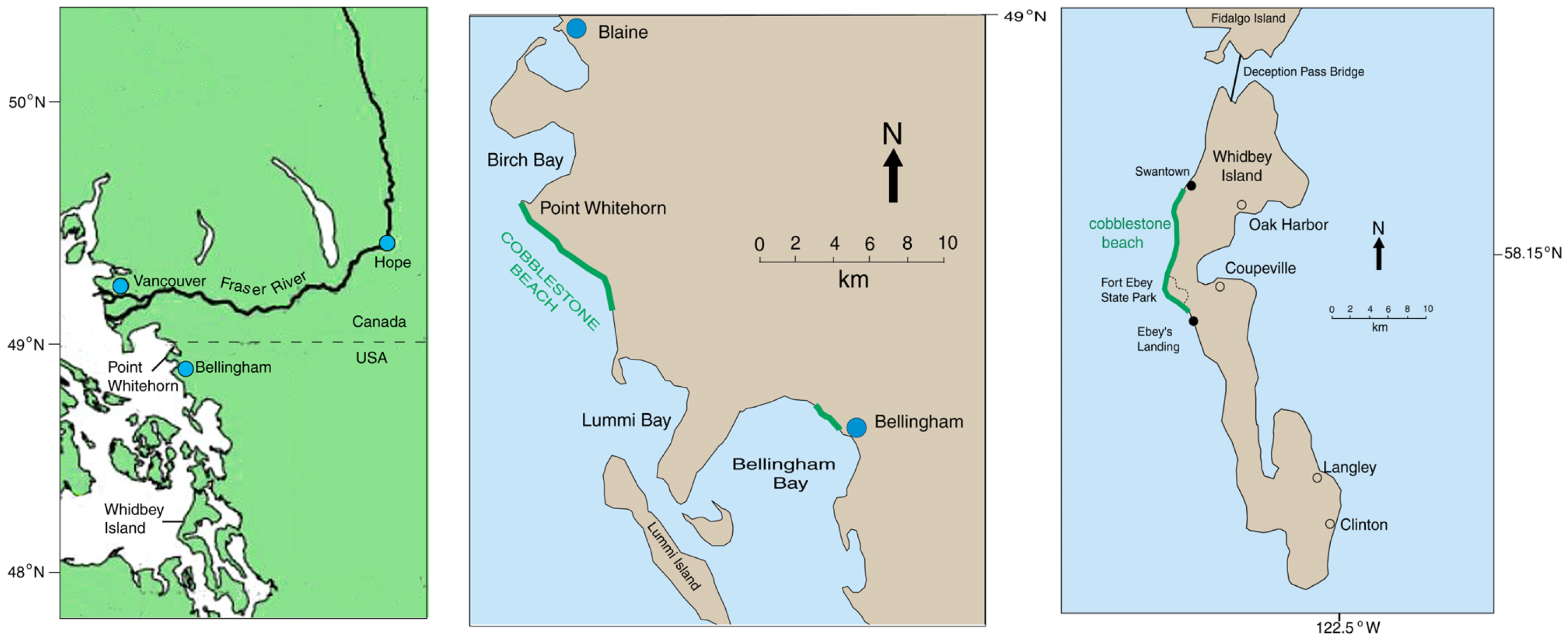
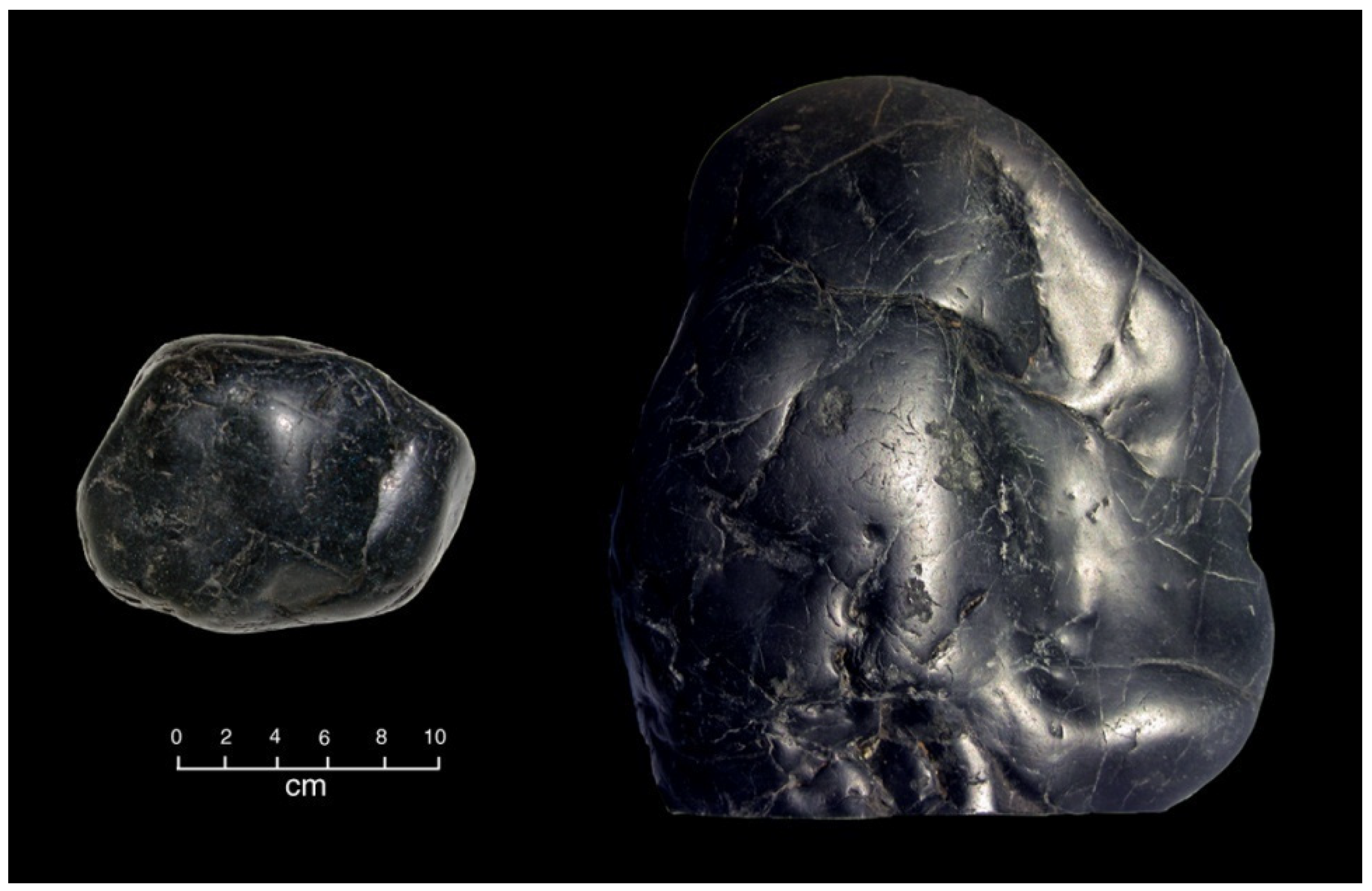
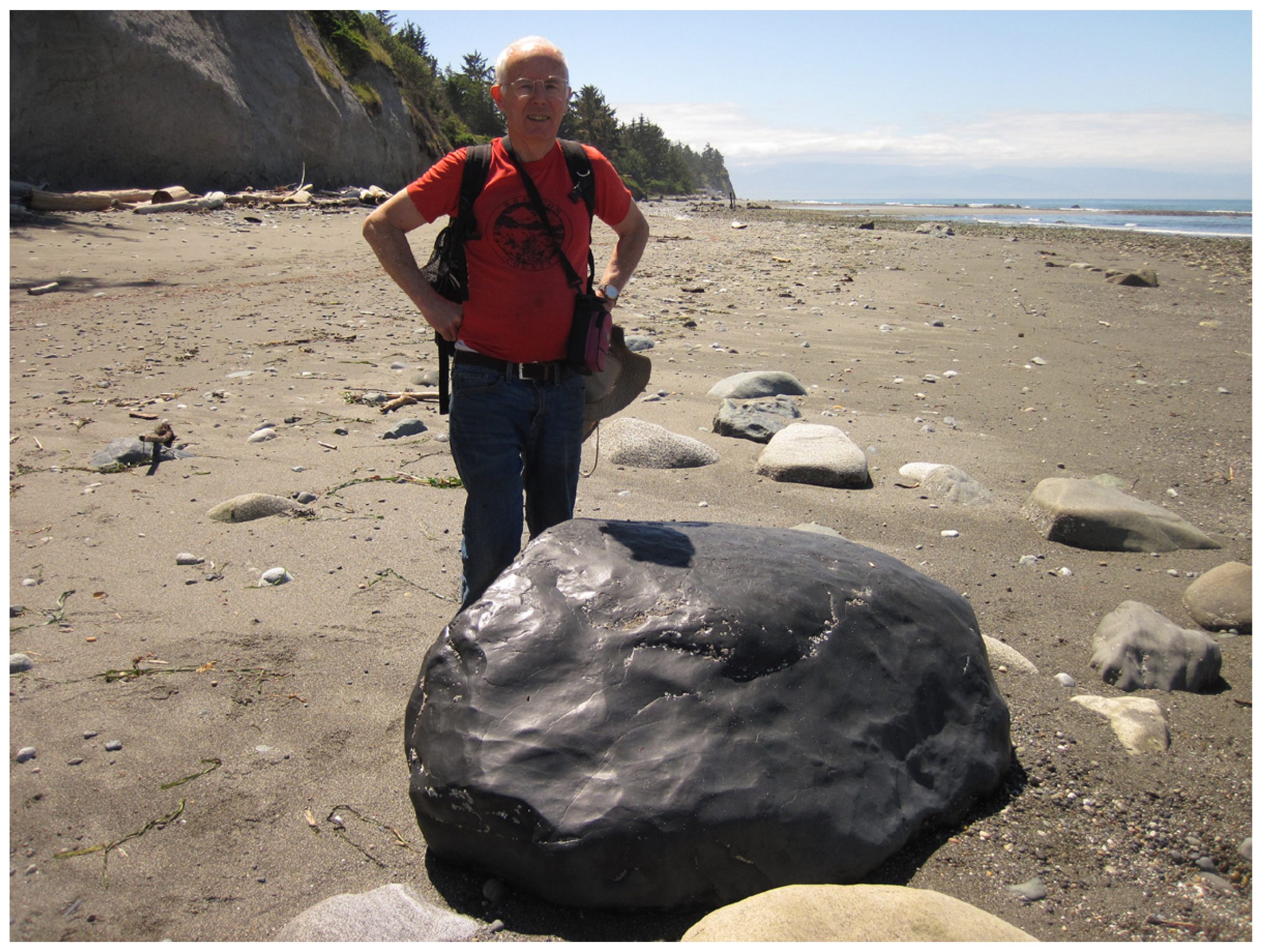
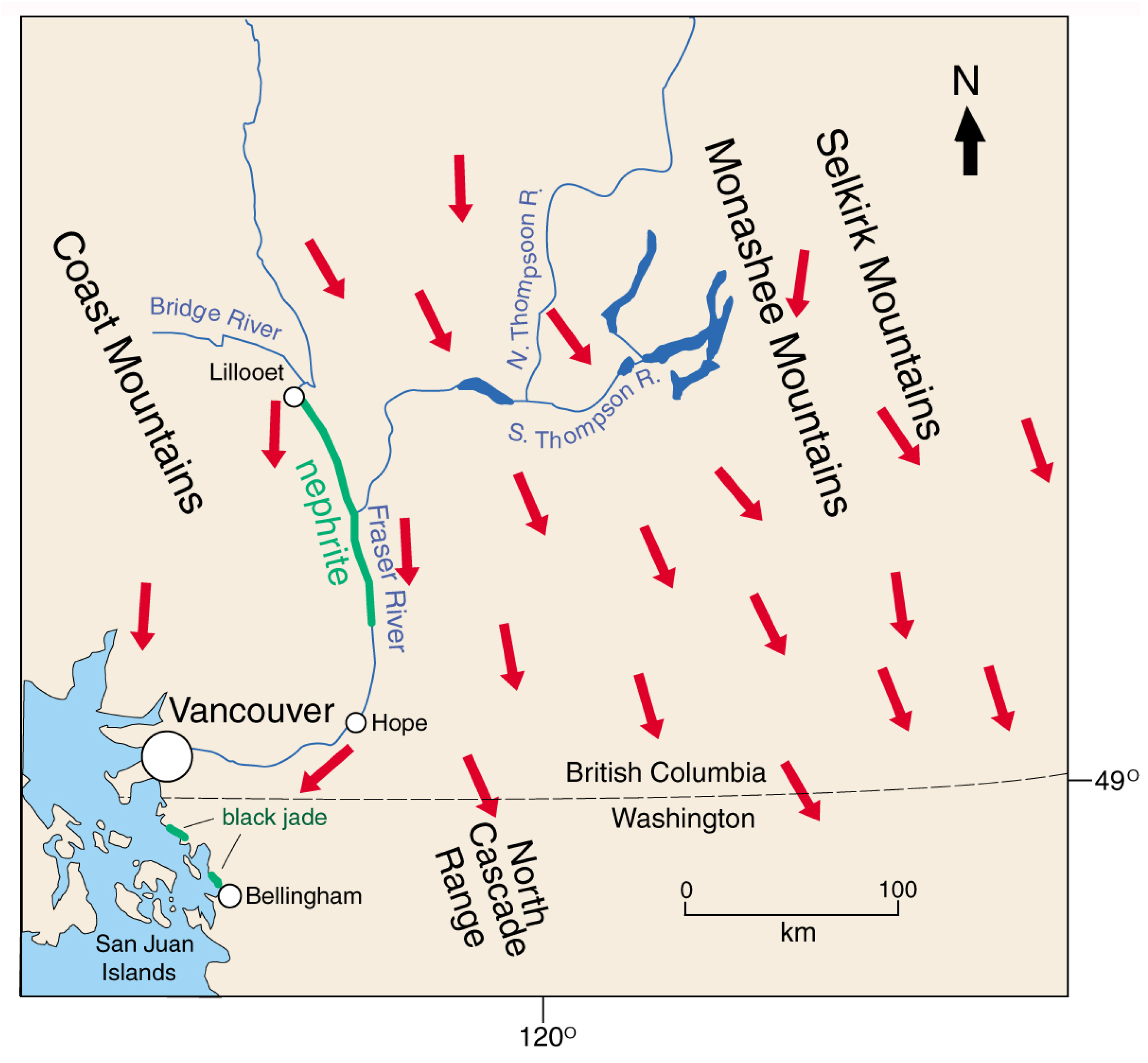

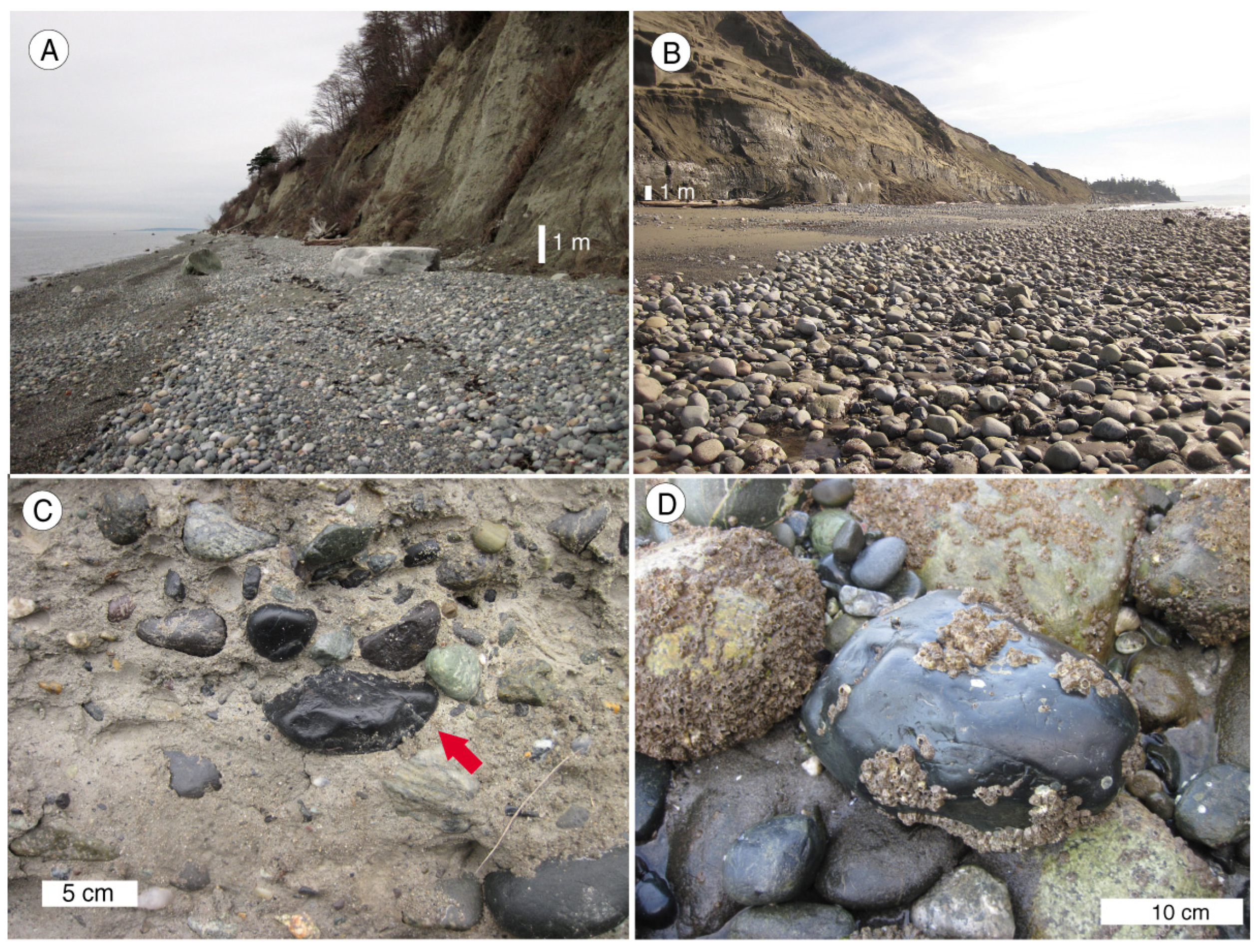

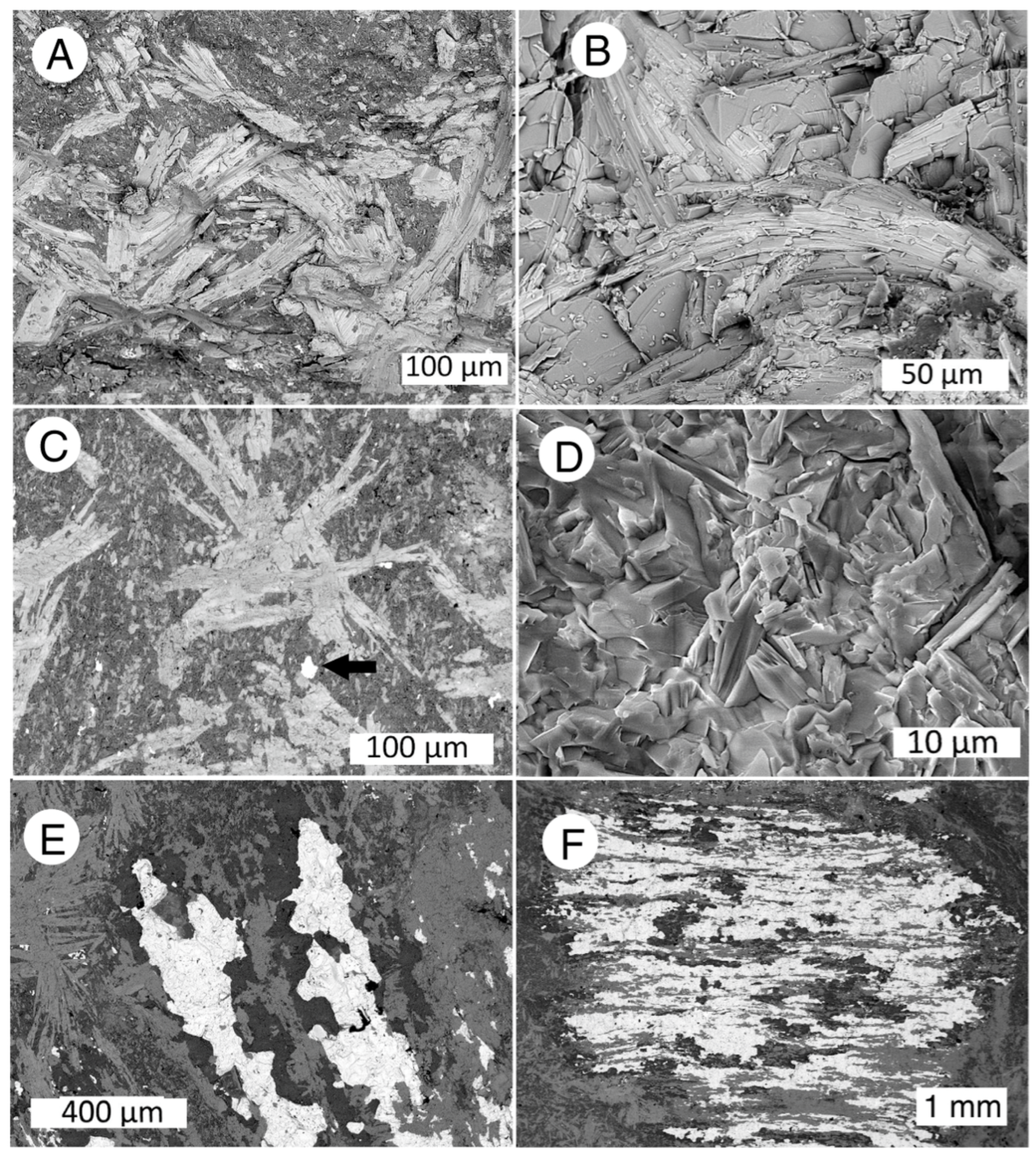

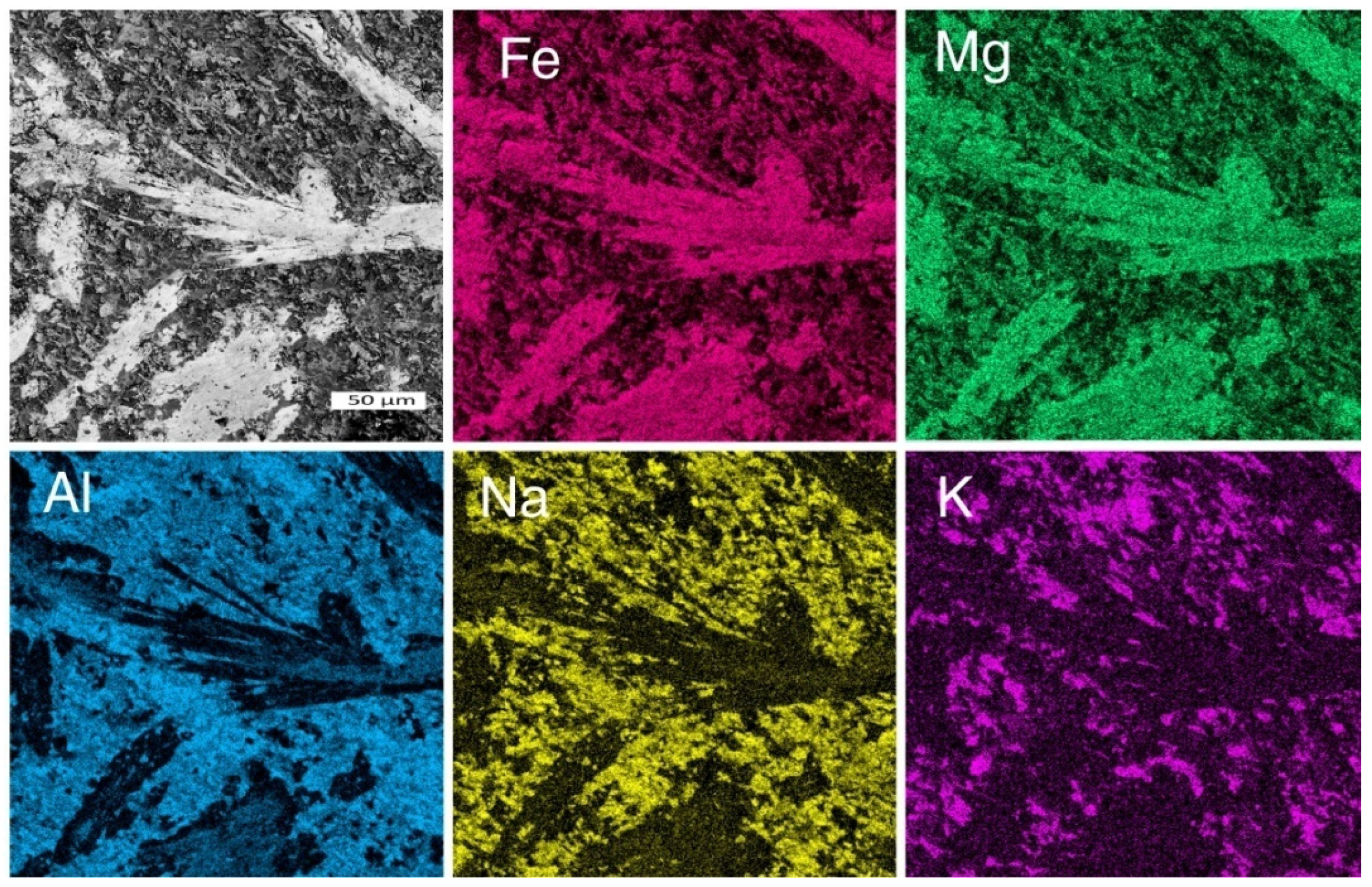


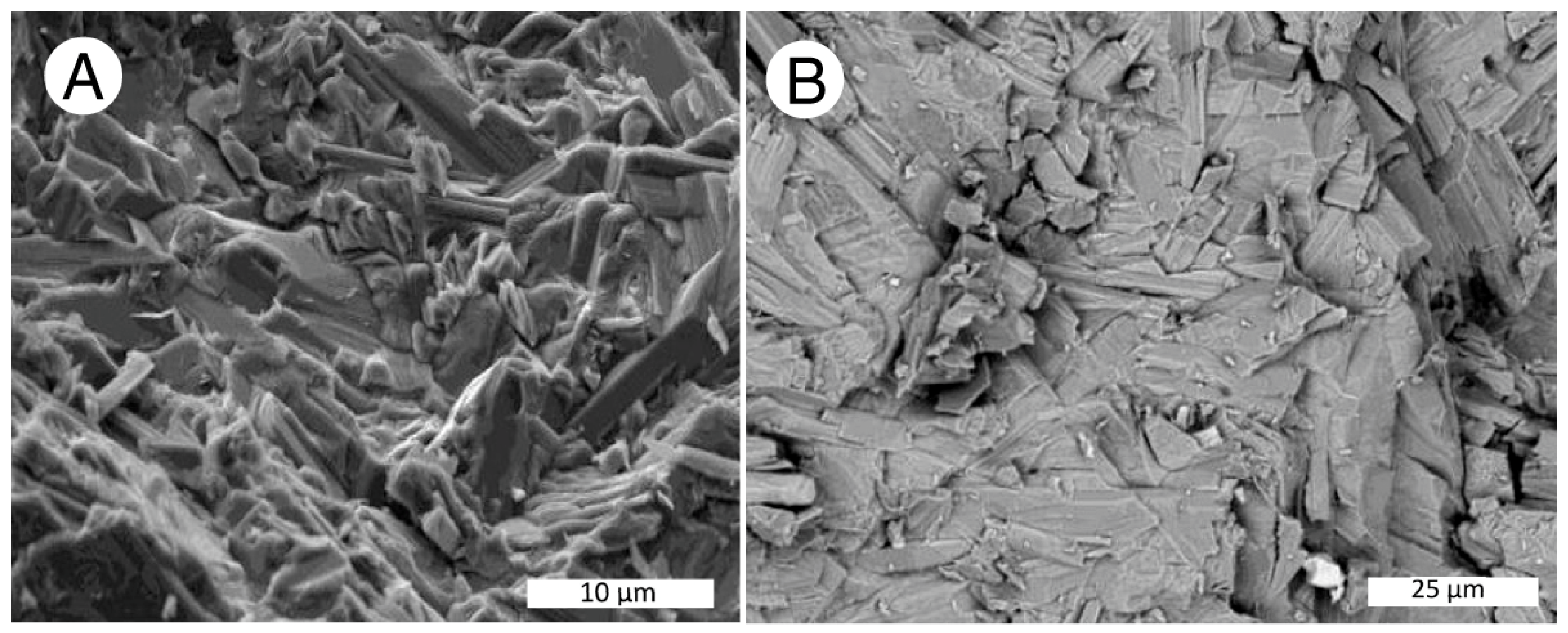
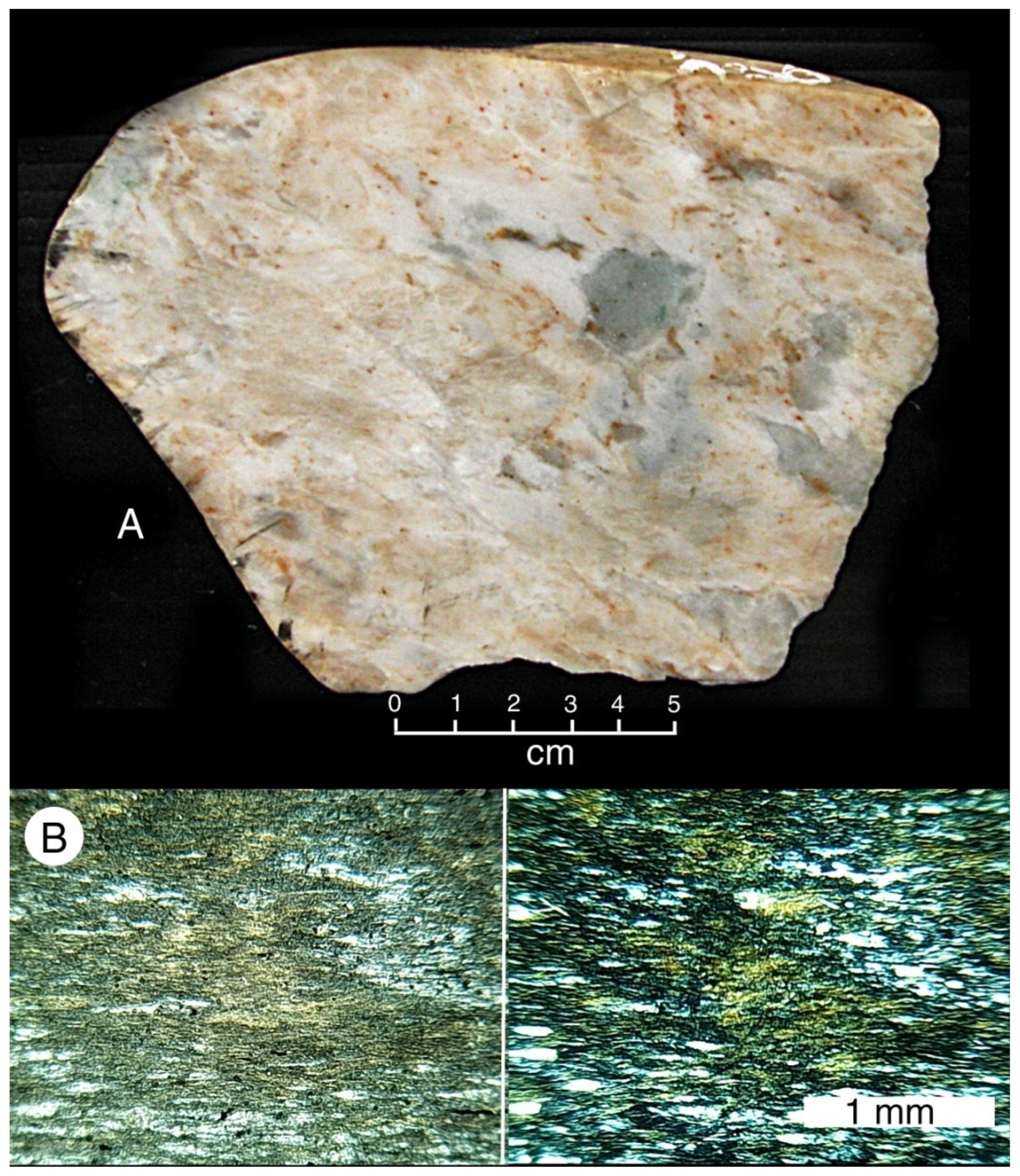
| 1 | 2 | 3 | |
|---|---|---|---|
| Oxide wt. % | |||
| SiO2 | 41.4 | 42.6 | 46.5 |
| TiO2 | 0.2 | 0.4 | 0.3 |
| Al2O3 | 7.1 | 7.8 | 9.2 |
| FeO * | 38.0 | 32.5 | 32.9 |
| MgO | 4.6 | 4.3 | 4.2 |
| CaO | 4.5 | 6.6 | 7.4 |
| Na2O | 0.9 | 1.0 | 1.3 |
| K2O | 0.2 | 0.2 | 0.2 |
| Element wt. % (cations) | |||
| Si | 19.4 | 19.9 | 21.7 |
| Ti | 0.1 | 0.2 | 0.2 |
| Al | 3.8 | 2.3 | 4.9 |
| Fe | 29.5 | 25.3 | 25.6 |
| Mg | 1.7 | 2.6 | 2.5 |
| Ca | 3.2 | 4.7 | 5.2 |
| Na | 0.7 | 0.7 | 0.9 |
| K | 0.2 | 0.2 | 0.2 |
| Atomic % | |||
| O | 55.0 | 59.9 | 59.8 |
| Si | 17.1 | 17.2 | 17.7 |
| Ti | 0.0 | 0.1 | 0.1 |
| Al | 3.5 | 4.0 | 4.4 |
| Fe | 13.1 | 10.8 | 11.11 |
| Mg | 2.9 | 2.6 | 2.5 |
| Ca | 2.0 | 3.1 | 3.3 |
| Na | 0.7 | 0.9 | 1.0 |
| K | 0.1 | 0.1 | 0.1 |
| Mg/(Mg+Fe) | 0.18 | 0.19 | 0.18 |
Disclaimer/Publisher’s Note: The statements, opinions and data contained in all publications are solely those of the individual author(s) and contributor(s) and not of MDPI and/or the editor(s). MDPI and/or the editor(s) disclaim responsibility for any injury to people or property resulting from any ideas, methods, instructions or products referred to in the content. |
© 2024 by the author. Licensee MDPI, Basel, Switzerland. This article is an open access article distributed under the terms and conditions of the Creative Commons Attribution (CC BY) license (https://creativecommons.org/licenses/by/4.0/).
Share and Cite
Mustoe, G.E. Pleistocene Glacial Transport of Nephrite Jade from British Columbia, Canada, to Coastal Washington State, USA. Geosciences 2024, 14, 242. https://doi.org/10.3390/geosciences14090242
Mustoe GE. Pleistocene Glacial Transport of Nephrite Jade from British Columbia, Canada, to Coastal Washington State, USA. Geosciences. 2024; 14(9):242. https://doi.org/10.3390/geosciences14090242
Chicago/Turabian StyleMustoe, George E. 2024. "Pleistocene Glacial Transport of Nephrite Jade from British Columbia, Canada, to Coastal Washington State, USA" Geosciences 14, no. 9: 242. https://doi.org/10.3390/geosciences14090242






